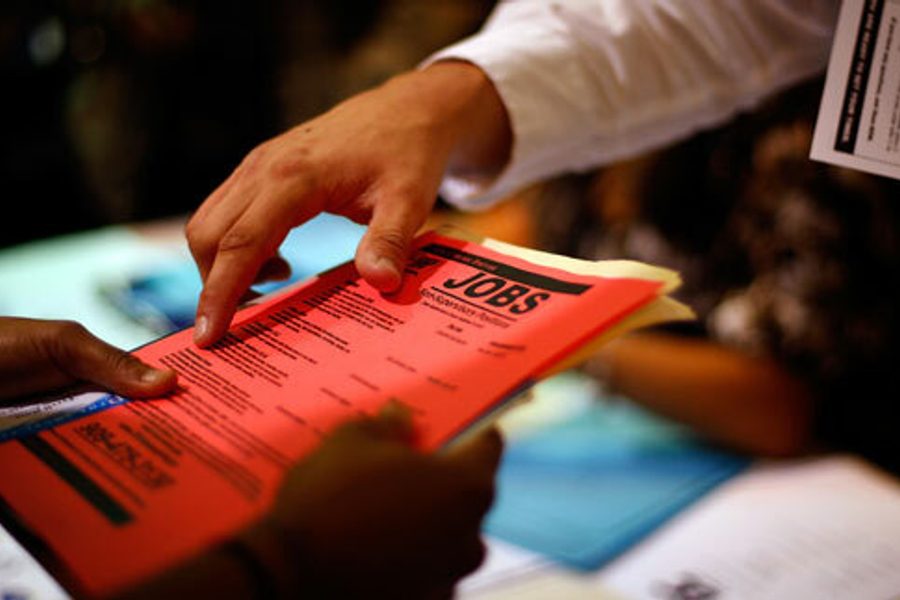
The latest unemployment report, showing an unemployment rate stuck at 9.7% in February, offers ambiguous signals about the pace and breadth of the recovery.
The picture is clouded in part by the impact of unprecedented snowfalls in February, which bogged down economic activity in much of the nation.
But more fundamentally, the figures simultaneously show a drastic slowing of job loss — 35,000 Americans lost their job last month, compared to 650,000 one year earlier — combined with the troubling persistence of long-term unemployment.
SHARPLY SLOWING LOSSES
Economist Dean Baker of the Center for Economic and Political Research, a sharp critic of the Obama Administration and Democrats’ tepid job-creation proposals in the face of the deep unemployment crisis, nonetheless saw very hopeful signs in the economic report, released by the Department of Labor Friday.
“It’s strikingly good,” Baker told the New York Times. “It’s much better than it had been looking.” The newspaper reported that experts expect the U.S. economy to “begin steadily gaining jobs during the spring, as employers edge toward hiring.”
The United States even added 1,000 manufacturing jobs in a sector that has been hammered not only by the recession, but by the persistent off-shoring of job to low-wage nations like China and Mexico. But this gain is tiny compared with the 5.6 million jobs in manfuacturing lost since 2000, representing 32% of the nation’s industrial employment.
TWO SEPARATE AMERICAS
“It’s almost two separate Americas,” said Lakshman Achuthan, managing director of the Economic Cycle Research Institute. One America is experiencing normalcy, while the other remains locked into the worst conditions seens since the Great Depression. “They have been left behind, and their problems are not solved by recovery.”
One indicator of the persisting crisis: males between the ages of 25 and 54 — in their primary erning years — have a 19.4% unemployment rate. The picture is far worse among African American and Latino workers.
The Times outlined a set of grim statistics that reveal ongoing long-term unemployment, and bleak prospects for bringing back high-wage manufacturing jobs given America’s de-regulated policy toward the export of jobs:
Nearly 15 million Americans were unemployed in February, and four in 10 had been there for six months or longer. The so-called underemployment rate — which counts people whose hours have been cut along with those working part time for lack of full-time positions — reached 16.8 percent, up from 16.5 percent in January.
Some labor experts say the downturn has accelerated a refashioning of the economy that has been under way for decades, eliminating jobs in less competitive industries — particularly manufacturing, and more recently, housing construction and financial services. In this view, many of those jobs are unlikely to return regardless of growth.
Another troubling sign: dropping housing prices. “Housing prices fell in January, prompting worries of another downturn that could hit homeowners and banks — a fear enhanced by a growing wave of foreclosures,” the Times noted.
For example, Janesville, Wis., where General Motors closed down a huge assembly plant and wiped out the last 2,800 jobs there after years of relocating work to Mexico, is a community already stretched to the limit by high unemployment, foreclosures, families running short of food, increasing homelessness, and high levels of spousal abuse.
But the town of about 60,000 is about to take another major hit. About 3,000 jobless workers — who have no realistic prospects, even after re-training — will be losing their unemployment benefits over the next couple months. This is expected to trigger a new round of foreclosures and a further unraveling of the community.
PROFESSIONALS HAMMERED AS WELL
Of course, the suffering is not limited to blue-collar communities. A professional woman in Georgia recently wrote me an e-mail detailing her bleak situation. She held an important human-relations job in a company before she was seriously injured in an auto accident.
“I had worked almost eight years at a job … that I loved and been promoted three times,” she writes. “When I came back to work from disability, I had a new boss and I was laid off.”
Even with college credentials and a professional expereience, she is finding work impossible to find. “I live in the highest unemployment county in Georgia,” she says. “Job fairs turn people away at the door, because there are so many of us trying to find work.”








